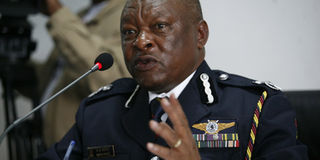Saitoti, Ojodeh ghosts haunt police airwing as senior officer faces panel

Kenya Police helicopter pilot Rogers Mbithi being interviewed in Nairobi on the 10th of January, 2014 by the police vetting board. The death of Internal Security Minister George Saitoti came back to haunt the vetting of senior police officers, when it was revealed that the aircraft were not serviced by technicians from the Force. PHOTO/EVANS HABIL.
What you need to know:
- Kenya Police Airwing Commandant Rogers Mbithi also ruled out the possibility of Prof Saitoti and his assistant Orwa Ojodeh to have ordered the pilot of the ill-fated helicopter to take off in bad weather.
- Col Mbithi said the maintenance of their planes, even the helicopter that killed Prof Saitoti, Mr Ojodeh and four police officers, were outsourced.
- According to the records, some have been involved in air accidents while others require overhaul.
The death of Internal Security Minister George Saitoti came back to haunt the vetting of senior police officers, when it was revealed that the aircraft were not serviced by technicians from the Force.
Kenya Police Airwing Commandant Rogers Mbithi also ruled out the possibility of Prof Saitoti and his assistant Orwa Ojodeh to have ordered the pilot of the ill-fated helicopter to take off in bad weather.
Colonel Mbithi, who also has the rank of a Deputy Commissioner of Police (DCP) said the decision to fly the chopper in which the two politicians were killed was made by the pilot.
“The pilot has the final say.
This is a song we sing every day,” he said, adding that since the overall responsibility for the safety of an aircraft, passengers and crew was with the pilot, no passenger was allowed to give instructions to the pilot.
There were concerns
“Sometimes we carry politicians but we have always reminded our pilots that they are in charge of the aircraft,” Col Mbithi said.
He was answering a question by the Rev Mike Harris, who pointed out that in the past, some senior government officials overruled pilots’ decisions asking them to fly even when there were concerns.
“Is there a clear understanding that once the officials get into the aircraft the pilot becomes the boss?” he asked.
Col Mbithi said the pilot of any aircraft had the final say on whether to fly or not and ruled out the possibility of both Prof Saitoti and Mr Ojodeh giving instruction to the pilots.
Since the aircraft are not supposed to carry civilians, passengers on the cabin are cut from the communication. They are only issued with ear guards and not headsets.
The police airwing boss further revealed the teething challenges facing his team, which include failure by the Kenya Civil Aviation Authority to authorise police to service their own aircraft, forcing them to outsource the services.
Col Mbithi said the maintenance of their planes, even the helicopter that killed Prof Saitoti, Mr Ojodeh and four police officers, were outsourced.
Although the unit had qualified and experienced engineers, and facilities, KCAA was yet to issue them with the Approved Maintenance Organisation certificate.
The panel was also told that though the airwing had experienced air crashes, none of the recommendations had been forwarded to the unit for implementation.
Col Mbithi added that they did not get the reports for the crashes that happened in Marsabit, Kapsabet, Wilson Airport, and even Ngong.
“We do not get the reports though we are the people supposed to implement them. However, it is not our duty to look for these reports,” he told the panel.
Pilots must have the overall control of the aircraft and should not take instructions from passengers, the panel vetting police officers has been told.
The commandant told the panel that the airwing serviced its fixed-wing aircrafts at the Kenya Wildlife Service while three Russian engineers have been attached to the unit to maintain the MI-17 helicopters.
At the moment, Col Mbithi said the police service has only one serviceable aircraft for rapid respond and support of the ground forces.
Out of the 13 aircrafts —5 fixed wing and 8 helicopters —owned by the unit, only two were operational.
According to the records, some have been involved in air accidents while others require overhaul.





